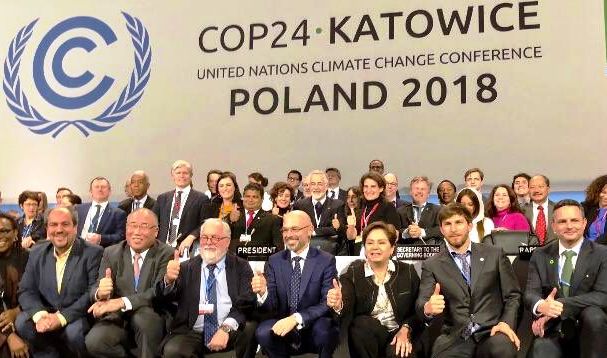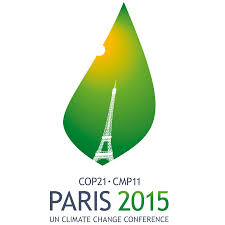Relevant for prelims and GS paper 3:-
- The UN Climate Conference (COP24) on December 14, 2018 saw the adoption of ‘Katowice package’, the rulebook for implementation of the 2015 Paris climate agreement.
- The Ministers of 200 nations reached consensus on rules after two weeks of intense negotiations during the 24th Conference of the Parties (COP24) to the UN Framework Convention on Climate Change (UNFCCC) that took place during December 2-14, 2018 in Katowice, Poland. The meeting was presided by Polish President, Michal Kurtyka.
- The adopted guidelines package aims to encourage greater climate action ambition and benefit people from all walks of life, especially the most vulnerable.
- The UN Secretary-General Antonio Guterres hailed the adoption of guidelines as a basis for a transformative process as this will require strengthened ambition from the international community.
- One of the key components is a detailed transparency framework to promote trust among nations. It sets out how countries will provide information about Nationally Determined Contributions (NDCs), including the reduction of greenhouse gas emissions.
- They agreed on the procedure to uniformly count the greenhouse gas emissions.
- If poorer countries feel they cannot meet the standards set, they can explain why and present a plan to build up their capacity in that regard.
- The document sets a way to decide on ambitious funding targets from 2025 onwards from the current commitment to mobilise USD 100 billion per year as of 2020 in support of climate action in developing countries.
- Nations agreed on the methodology to collectively assess the effectiveness of climate action in 2023, and finalised the procedure to monitor and report progress on the development and transfer of technology.
- The concerns of developing nations including India and least developed nations on funding for carbon credit were finally addressed.
- The rich nations which are the main polluters agreed to pay for greening in the underdeveloped world.
- The agreed guidelines mean that countries can now establish the national systems that are needed for implementing the Paris Agreement by 2020.
Issue of market mechanisms still needs to be resolved:-
- The main issues still need to be resolved such as the use of cooperative approaches, as well as the sustainable development mechanism. Resolution of these issues would allow countries to meet a part of their domestic mitigation goals through the use of “market mechanisms”.
- Market mechanisms provide flexible instruments for reducing the costs of cutting emissions, such as carbon markets.
- These negotiations will further be taken up for talks at the UN climate change conference, COP25, set to take place in Chile.
Fiji-led Talanoa Dialogue concluded:-
- The Fiji-led Talanoa Dialogue, a year-long inclusive dialogue that relates to the Paris Agreement, was also concluded at COP24, with the global warming of 1.5 degree Celsius report by the Intergovernmental Panel on Climate Change (IPCC) as a major input.
- There is a clear recognition of the IPCC’s role in providing scientific input to inform countries in strengthening their response to the threat of climate change.
- ‘Talanoa Call for Action’ calls upon all countries and stakeholders to act with urgency.
- Countries are encouraged to factor the outcome of the dialogue into efforts to increase their ambition and to update their nationally determined contributions in 2020.
Paris Agreement on Climate Change:-
- In December 2015, 195 countries pledged to slow the process of global warming in Paris by signing the Paris Agreement on Climate Change.
Objectives
- The primary objective is to limit the global average temperature to well below 2 °C above pre-industrial levels.
- Efforts will be made to limit the temperature increase to 1.5 °C above pre-industrial levels so that it will be possible to reduce the risks and impacts of climate change.
- Parties should take action to conserve and enhance, as appropriate, sinks and reservoirs of greenhouse gases including forests.
- With a view to contribute to sustainable development and to achieve the long term temperature goal of 2°C, the COP established the global goal on adaptation of enhancing adaptive capacity, strengthening resilience and reducing vulnerability to climate change.
Mitigation
- Parties recognised the importance of averting, minimising and addressing loss and damage associated with the adverse effects of climate change, including extreme weather events and slow onset events, and the role of sustainable development in reducing the risk of loss and damage.
Technology Transfer
- Parties share a long-term vision on the importance of fully realising technology development and transfer in order to improve resilience to climate change and to reduce greenhouse gas emissions.
Financing
- Developed countries will raise finances to the tune of 100 billion US dollars per year by 2020 to help developing nations in both mitigation and adaptation activities. And, other nations are encouraged to provide funding voluntarily.
Implementation
- A mechanism to facilitate implementation of and promote compliance with the provisions of this Agreement is hereby established.
Review
- The Conference of the Parties serving as the meeting of the Parties to the Paris Agreement shall undertake its first global stock take in 2023 and every five years thereafter.
Enforcement
- This Agreement shall enter into force on the thirtieth day after the date on which at least 55 Parties to the Convention have deposited their instruments of ratification, acceptance, approval or accession.
Signing & Ratification
- As of June 2017, 195 UNFCCC members have signed the agreement, 148 of which have ratified it.
US Withdrawal
- On June 1, 2017, US President Donald Trump announced to withdraw the United States from the 2015 Paris agreement, stating that the Paris accord would undermine the U.S. economy, cost U.S. jobs, and weaken American national sovereignty.




